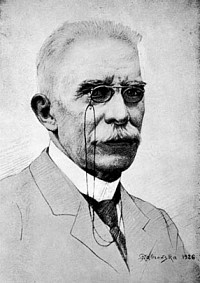 |
 |
French chemist Henri le Châtelier (1850 - 1936) first stated a principle that
describes how systems at equilibrium respond to change. It is important to note that
this is an example of a scientific law – it describes (and lets us predict) what systems
at equilibrium do, but it does not explain why they do it. It is also qualitative in that it
describes in general, rather than predicting any measured values. It is a useful
tool, as it gives us a quick way to predict what should happen in an equilibrium when we
apply a change to it. However, if we need to know quantitatively what
happens, then we must use another method – the equilibrium rate law expression, which
will be described later.
le Châtelier's PrincipleIf a system at equilibrium is subjected to a change, the system will react in a way that minimizes the effect of the change. |
 If any reactant increases, all the reactants will increase and all the products must decrease. Similarly if any product increases, all the products will increase, and all the reactants must decrease. |
When working with le Châtelier's principle, it is often useful to treat the equilibrium like a see-saw. The balance point of the see-saw is the equilibrium symbol. Recall how a see-saw works and it is obvious that everything on the same side of the balance point moves in the same direction, and that it moves in the opposite direction to things on the other side of the balance point.
le Châtelier's principle applies to equilibrium systems that are changed. However, since an equilibrium can only occur in a closed system, it should be obvious that you can't apply le Châtelier's principle unless you temporarily open up the system to change it. If you then close the system again, it will respond in the way predicted by le Châtelier's principle as it returns to equilibrium.
The change applied to the reaction is usually called a "stress". It can be very useful to show how the reaction responds to the stress using a table like this:
| Applied Stress | Le Châtelier's Principle Prediction of Response to Stress |
|||
| Reactants | + energy | Products | ||
| Increase T | ||||
Reaction shifts to the right |
||||
| Decrease T | ||||
Reaction shifts to the left |
||||
The colored words (or arrows) show the initial change the reaction makes to the applied stress. The black words (or arrows) show how the other substances in the reaction respond to the "colored" change. Remember to make use of the "see-saw" effect, so everything on one side of the equilibrium sign responds in the same way, and opposite to the other side.
If the temperature drops, the reaction's response is to try and increase the energy. If the temperature rises, then the reaction responds by trying to decrease the energy.
Lo-tech!Don't forget the obvious! Although the diagrams shown in this material are computer images, you'll be doing the same thing but with a paper and pencil. For example, here is the stress table you will create to identify the effect of a temperature increase on the reaction: 2NO2 (g) |
Another method used to describe le Châtelier's principle is to state that the reaction "shifts right" or "shifts left". If a reaction has an increase in its products, then it is said to shift to the right. If it has an increase in its reactants, then it is said to shift to the left.
| When solving an equilibrium problem using le Châtelier's principle it is
best to: 1. Identify the stress 2. Identify how the system will respond to the stress. Remember that the system will always do the opposite of the applied stress. 3. Identify how each other substance will respond to the change, using the "see-saw" effect. |
Finally remember that this is only a counteracting principle. If we increase something in a reaction, that thing will go up. However, it won't increase as much as it would have if there was no counteracting response from the system.
Since we have already shown that only the following changes to reactions can change equilibria, let's look at examples of each to see how the system will respond: